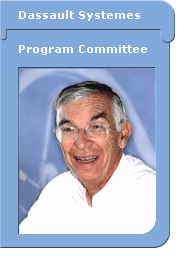
New Technology For Solving Large-Scale Geometrical Networks
(co-authors: Alain RIVIERE, Philippe SERRE)
Geometrical models developed with CAD/CAM software were initially of the Brep (boundary representation) type, followed by CSG (constructive solid geometry), parametric and, finally, variational. From a manufacturing standpoint, extremely large-scale, 3D geometrical problems need to be declared and resolved. Tensorial modelling culminating in the resolution of a minimum number of equations will therefore be presented and illustrated in this paper.
In 1961, after graduating from the Ecole Normale Superieure de Cachan, France, as a mechanical engineer, Andre Clement first taught as professor at the high school. He then focused more particularly on research: as Doctor of 3° cycle in 1976, Doctor of State in 1982 and finally as Professor of University in 1989.
In 1982, he started his own development Mechatronic Laboratory at I.S.M.C.M. Saint Ouen (France) where he directed numerous thesis on the recognition and generation of geometric shapes. A. Clement is also an active member of the C.I.R.P., visiting professor at NIST, MIT and PTB (Germany).
He left university in 1992 for industry.
Hired as Dassault Systemes's scientific advisor, A. Clement is responsible for discovering leading-edge technologies through research and contractual agreements to continuously improve CATIA, its CAD/CAM software.
His research work at that time was more focusing on macro-tolerancing for mechanical parts (the TTRS theory has been adopted at the last meeting of the ISO committee as the basis for tolerancing parts) and micro-tolerancing for geometrical CAD/CAM objects.
In 1998, he retired partially, and became consultant for Dassault Systemes and emeritus professor at ISMCM.
His research work today is focusing on "declarative geometry", a constraint based approach of CAD/CAM system.